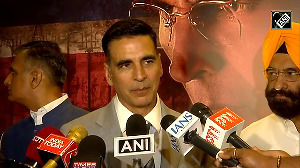Senior artists like Atre make up a significant but small percentage of Ninaad's classical music catalogue; its growing focus is promoting undiscovered talent. More importantly, it is one of the few record labels that continues to record fresh classical releases - up to 12-15 in a good year.
This method of re-release has become the model of content creation in an industry that appears to no longer find viability in producing new content. The Indian classical music industry is stuck in a rut, and topmost on everybody's blame list is the record label.
"Where is the musical diversity that India is known for? When categories like classical music are relegated to the back of the store where five racks have become one rack, you know we have a problem," says vocalist Shubha Mudgal, her kohl-lined eyes glinting in irritation.
Erstwhile champions of the category like Saregama and Music Today are being held answerable for not sustaining their interest in the genre and repackaging their existing inventory. Saregama admits it has not launched a single new artiste in the last five years in the classical genre.
Gurmeet Singh, managing director, Music Today, is defensive - if the entire music industry has slipped from Rs 1,200 crore (Rs 12 billion) in 2002 to Rs 600 crore (Rs 6 billion) today, the share of classical music is no more than Rs 10 crore (Rs 100 million).
"Sales in the classical music category have been stagnating. It has occupied 3.5 per cent of Planet M's total business for the last two years," says Ajay Mehra, CEO, Times Retail. To put that in perspective, Hindi film music contributes to 50 per cent of Planet M's business. "Contrary to popular belief, sales figures show little variance between northern and southern markets," says Mehra.
At Rhythm House, a music store in Mumbai's Kala Ghoda district, you will still find over 1,500 Indian classical titles, but Mehmood Curmally, the store's director, says new releases at the store are down to less than 30 a year. "The others are all re-hashed compilations," he explains. "What's happening is that more people are listening to more music but much of it is on the radio or on the mobile phone," retorts Singh.
Over the last 10 years most recording companies - Sony, Times Music and Venus - have ventured into, and exited, classical music. "Not every company has the understanding or the wherewithal to manage the category," says Singh.
Rhythm House itself has long stopped recording under its eponymous record label, now only digitising content and packaging existing recordings into CD formats. They had a splendid beginning with the first ever Gundecha Bandhu recording to their credit, as well as some of the earliest dhrupad recordings like those of Uday Bhawalkar. "Sadly, it's just too draining on our resources to continue," admits Curmally.
So where are the new voices? And fresh talent? It has been left to smaller labels like Alurkar and Ninaad to provide recording opportunities to younger voices like those of Jayateerth Mevundi of the Kirana gharana. "That Alurkar is still around means something's working," says Mudgal of her first record label. Mahesh Babu, founder Ninaad, says a fifth of its artiste list is debut talent.
"If young talent has been recorded, it is the offspring or disciples of the really big artistes," bemoans Shashi Vyas, who runs Pancham Nishad, an organisation that promotes classical music. Music Today, for instance, launched a series called "Dharohar", featuring children of well-known singers like Srinivas Joshi and Kalapini Komkali.
Abhay Rustom Sopori, the 28-year-old santoor maestro and music composer, agrees that as son of santoor virtuoso Pandit Bhajan Sopori, recording opportunities came easier to him than others. "I sometimes blame musicians for underselling themselves. They are willing to take on all production expenses and surrender worldwide rights in perpetuity to a label as long as they're backed by them," he says.
Sopori has released more compositional regional albums than classical compositions, and performs at anywhere up to 100 concerts a year. "No longer do artistes see record labels as benefactors who will promote them in a sustained manner," says Babu.
Mudgal highlights the example of a sixth-generation sarangi player being asked by a prominent record label if he could play the piano instead. "Younger artistes are a disillusioned lot," she says, "and then we wonder when they opt out of pure classical sound."
The reason few new artistes are launched today is that they don't have the kind of appeal that the maestros have, says Singh. "Sometimes we hardly sell 300 CDs of a newer artiste whereas we need to sell at least 1,000 to break even."
"Whether that is a result of marketers not spending enough resources promoting new talent or that demand is simply not there is a bit of a chicken-and-egg situation," Mehra says. "It is still artistes like Veena Sahasrabudhe that have the power to sell 3-4 CDs every day," agrees Curmally.
It's not there isn't any talent. Vidyadhar Vyas, executive director at ITC's Sangeet Research Academy, says, "There's an abundance of talent but recording companies are driven by commercial considerations." Pancham Nishad conducts a popular annual programme called Aarohi where it showcases six new artistes from across the country.
In Mumbai, The Fine Arts Society, a 45-year- old non-profit cultural organisation, conducts over 60 events a year, several of which focus on young classical music talent. "It is cultural bodies that are keeping the genre alive, not record labels," says K Ganesh Kumar, president and trustee.
Not surprisingly, young artistes like flautist Ronu Majumdar produce their own CDs to sell at concerts. Chitravina virtuoso Ravi Kiran has always preferred to work with foreign labels. "They are more professionally inclined," he says, "Royalty payments have always been a sticky issue with Indian labels."
According to industry sources, artiste royalty payments are between 6-12 per cent. Kiran uses his own website as a distribution channel for his music, complete with QuickTime downloads. "A little bit of enterprise can only be helpful these days," he laughs.
What is more shocking, according to Vyas, is that even All India Radio has stopping airing its regular classical programmes and now has just a handful dedicated to classical music. Ninaad creates additional sales platforms for its musicians through unique branded events organised by its sister event management company, Banyan Tree.
To fill the void left by shrinking distribution platforms, Mudgal and husband, tabla-soloist and composer Aneesh Pradhan, created Underscore Records, a distribution channel for independent labels. Not only does Underscore restore archival recordings, it also works as a fair-trade, non-exclusive distribution channel (distributing royalties in an 80:20 ratio) for serious amateur musicians, occasionally making their own recordings. "We recorded artistes like Kausalya Manjeshwar and Dr Ashok Ranade when they were past their performing age," says Mudgal.
But artistes say it's not just an issue of poor content creation, it's also quality of production. "You can see the recording labels' attitudes are changing. They used to be particular about where they recorded; now the cheapest studio will do. Compilations are unethically re-hashed, and inlay quality is appalling. It's clear they believe other genres are more profitable," says Mudgal.
Subroto Chattopadhyay, managing director, Saregama, claims classical music still accounts for 20 per cent of his company's turnover. Classical music also accounts for about 30-35 per cent of Music Today's revenues. But, record firms claim, they're not making too much money.
Some suggest the growing demand for other traditional music genres like spiritual music is another reason why record labels are losing interest in classical music. Spiritual music accounts for a fifth of Music Today's top line.
"If Ninaad were to do only what sells, classical music would probably be drowned out by the spiritual category," admits Babu, referring to the successes of Ninaad's "Benares priests chanting" series. Singh disagrees, "All genres have become more or less equally profitable because where the volumes are low, the MRPs are high and vice-versa."
But it's not just record labels in the line of fire. Sopori says even concert organisers are profit-oriented. Sources indicate that even at established Indian venues, payouts can be as low as Rs 2,500-5,000 per event, to be disbursed between the artiste and the team of accompanists.
"Why aren't more business houses nurturing and sponsoring prodigious talent in classical music?" asks Mudgal. Music Today conducts about 40 classical music events annually and Singh indicates it's far easier to get corporate sponsors for youth-oriented brands. Pancham Nishad's Vyas agrees.
"While companies like Union Bank, Dena Bank , the Tatas and Videocon do come forward to sponsor programmes, it's not enough." Kumar, on the other hand, indicates that The Fine Arts Society has always managed to attract corporate funding for its events. "We have to learn to market classical music in a way that companies see sense in being associated with it," he says.
Citigroup, for one, has been sponsoring annual concerts - Gunidas and Banganga - in Mumbai for over 15 years now. Says Madhulika Gupta, director corporate affairs, Citigroup, "We have now taken Gunidas to four cities, introducing Chennai last year, to preserve and promote the genre." Britannia has also been sustaining the St Xavier's College Indian Music Group and its reputed annual concert Jan Fest year after year.
So is there an audience for Indian classical music? "How can record labels claim the genre is not profitable when our concerts are packed every time?" asks Mudgal. "Tastes keep changing. Indipop is dead. What's in vogue currently is instrumental music with ambient classical sounds," says Singh.
Ganesh Kumar rebuffs record labels' claims that demand has dipped. "Seven years ago we had 150-200 students at our music school. Today we have 700. Real music lovers aren't seen hanging around retail shelves, they go to concerts," he says, citing the example of the Chennai December Festival where up to 400 events are still held each year.
"A violin costs between Rs 6,000-8,000. We need to institutionalise learning so that investment is not a deterrent for youth to engage with classical music," says Kumar. The Fine Arts Society School owns over 500 musical instruments.
"Ultimately," says Ravi Kiran, "record labels will realise that the only way to inject excitement into the category is to update the platform of technology on which it is presented."
Earlier this year Kiran launched Shakti Extratainment, India's first IPTV (Internet Protocol Television) channel for global audiences, devoted to Indian classical and contemporary culture, of which classical music is a key component. "With content that ranges from concert recordings to recorded music lessons from distinguished gurus like Shri Tanjavur Shankara Iyer, I hope to create invaluable references for future generations," he says.
Ninaad also wants to prove that with new concepts of branding and marketing classical music can be kept alive. "We're going to try and start selling the concept of modern-format music videos to both artistes and the music channels." An earlier attempt in 1997 failed.
Meanwhile the biggies too offer hope. Music Today, which brings out a total of 30-35 albums each year across genres, finally plans to launch Jayateerth Mevundi. "We are trying to introduce new talent; we've tied up with ICCR (Indian Council for Cultural Relations) for the release of some new albums," say Singh.
Chattopadhyay says recent research conducted by Saregama reveals that 83 per cent of the purchases of classical music were made by people under 44 and 30 per cent of the demand was from people below the age of 24. "There appears to be a franchise among youngsters," he admits.
Chattopadhyay says it has 900 active titles out in the market and is in the process of digitising the content of 12,000 pieces, "In the next few years we will become a serious content creator," he says. Music lovers will have to decide if that's worth holding their breath to.
After Them, Who?
SITAR
Vilayat Khan (1928-2004)
Nikhil Banerjee (1931-1986)
Ravi Shankar (1920- )
Successor:
Budhaditya Mukherjee (1955- ) <BR>
SAROD
Ali Akbar Khan (1922- )
SHEHNAI
Bismillah Khan (1916-2006)
TABLA
Allah Rakha (1919-2000)
Zakir Hussain (1951- )
FLUTE
N Ramani (1934- )
Hari Prasad Chaurasia (1938- )
VOCALISTS
Bade Ghulam Ali Khan (1902-1968)
Gangubhai Hangal (1913- )
Bhimsen Joshi (1922- )
Pandit Jasraj (1930- )
Kishori Amonkar (1931- )
Successors
Veena Sahasrabudhe (1948- )
Rashid Khan (1966- )
Jayateerth Mevundi (1972- )








 © 2025
© 2025